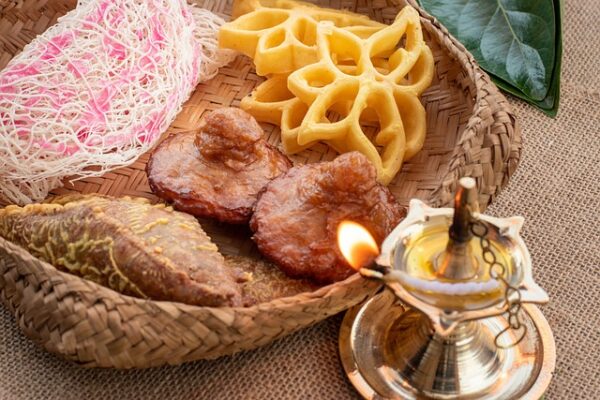Sweet Delights of Sinhala and Hindu Aluth Aurudu Traditions: Exploring the Cultural Tapestry of Sri Lanka’s New Year Treats – By Malsha – eLanka

In the vibrant cultural mosaic of Sri Lanka, the Sinhala and Hindu New Year, commonly known as Aluth Aurudu, is a time of immense celebration and joy. Central to these festivities are the delectable traditional sweets that are lovingly prepared and shared among families and communities. These sweets not only tantalize the taste buds but also carry deep cultural significance, reflecting centuries-old customs and traditions passed down through generations.
Symbolism of Sweets in Aluth Aurudu:
In Sinhala and Hindu New Year celebrations, sweets hold a special place, symbolizing prosperity, happiness, and the sweetness of life itself. Each sweet is carefully crafted with a blend of indigenous ingredients, aromatic spices, and culinary techniques that have been perfected over time. From the preparation to the presentation, every aspect of making these sweets is steeped in tradition, making them an integral part of the New Year festivities.
Traditional Sinhala Sweets:
One of the hallmark sweets of Sinhala Aluth Aurudu is “Kokis,” a crispy deep-fried delicacy made from a batter of rice flour and coconut milk. The intricate patterns formed during frying give Kokis its distinctive appearance, making it not only delicious but also visually appealing. Another beloved treat is “Kavum,” small oil cakes made from rice flour, jaggery (palm sugar), and coconut, often flavored with cardamom or nutmeg. Kavum comes in various shapes, such as diamond or rectangular, and is fried to golden perfection.
Hindu Aluth Aurudu Sweets:
In Hindu households, Aluth Aurudu is celebrated with equal fervor, accompanied by a unique array of traditional sweets. One such delight is “Athirasa,” a sweet made from rice flour, jaggery, and grated coconut, deep-fried to a crisp texture. Athirasa is believed to bring prosperity and good fortune to the home, making it an essential part of the New Year festivities. Another popular sweet is “Mung Kevum,” made from green gram flour, coconut, and jaggery, shaped into small balls and fried until golden brown.
Shared Traditions and Cultural Harmony:
What makes Aluth Aurudu truly special is the way it transcends cultural boundaries, bringing together people of different ethnicities and religions in a spirit of unity and harmony. While the specific sweets may vary between Sinhala and Hindu communities, the underlying sentiment of joy, renewal, and togetherness remains the same. Families open their homes to friends and neighbors, exchanging sweets and good wishes as they usher in the New Year with hope and positivity.
Preserving Heritage Through Sweets:
As Sri Lanka continues to modernize, there is a growing awareness of the importance of preserving cultural heritage, including traditional culinary practices. Many organizations and individuals are working tirelessly to document age-old recipes, techniques, and rituals associated with Aluth Aurudu sweets, ensuring that they are passed down to future generations. Through initiatives such as cooking workshops, recipe books, and cultural festivals, these efforts seek to celebrate and safeguard Sri Lanka’s rich culinary heritage.
Conclusion:
In conclusion, the traditional sweets of Sinhala and Hindu Aluth Aurudu are not just desserts but embodiments of culture, heritage, and community spirit. As Sri Lankans come together to celebrate the New Year, they savor not only the flavors of these delectable treats but also the richness of their shared cultural identity. With each bite, they honor the traditions of the past and pave the way for a future filled with sweetness and joy.







